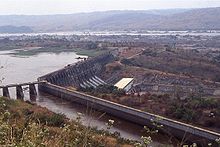| Inga Dams | |
|---|---|
 Inga I dam, with the feeding canal for Inga II in the foreground. | |
| Country | Democratic Republic of the Congo |
| Coordinates | 5°31′09″S 13°37′19″E / 5.51917°S 13.62194°E |
| Status | Operational |
| Construction began | Inga I: 1968 Inga II: |
| Opening date | Inga I: 1972 Inga II: 1982 |
| Power Station | |
| Turbines | Inga I: 6 x 58.5 MW Inga II: 8 x 178 MW |
| Installed capacity | Inga I: 351 MW Inga II: 1,424 MW |
The Inga Dams (French: Barrages d'Inga; Dutch: Ingadam) are two hydroelectric dams connected to one of the largest waterfalls in the world, Inga Falls. They are located in the western Democratic Republic of the Congo and 140 miles southwest of Kinshasa.
Inga Falls on the Congo River is a group of rapids (or cataracts) downstream of the Livingstone Falls and the Pool Malebo. The Congo falls ~96 metres (315 ft) within this set of cataracts. The mean annual flow rate of the Congo River at Inga Falls is ~42,000 cubic metres per second (1,500,000 cu ft/s). Given this flow rate and the 96-metre fall, the Inga Falls alone has a potential to generate ~39.6 gigawatts (53,100,000 hp) of mechanical energy and nearly as much electrical energy.
Inga Falls is currently the site of two large hydropower plants and is being considered for a much larger hydro power generating station known as Grand Inga. The Grand Inga project, if completed, would be the largest hydro-electric power generating facility in the world. The current project scope calls for the use of a flow rate ~26,400 cubic metres per second at a net head of ~150 metres; this is equivalent to a generating capacity of ~38.9 GW. This hydro-electric generator would be more than double the current world record holder, which is the Three Gorges Dam on the Yangtze River in China.
Grand Inga is a "run-of-the-river" hydroelectric project in which only a relatively small reservoir would be created to back up the power of the river's flow. This would be so that the net head for the hydroelectric turbines could approach 150 metres.
